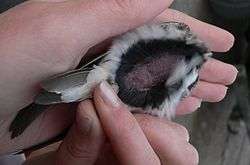Brood patch

A brood patch is a patch of featherless skin that is visible on the underside of birds during the nesting season. This patch of skin is well supplied with blood vessels at the surface making it possible for the birds to transfer heat to their eggs when incubating.[1] In most species the feathers in the region are shed automatically but ducks and geese may pluck the feathers and use them to line the nest. The feathers of the region regrow soon after the eggs hatch in the case of precocial birds but may be delayed in those birds having altricial young.
The positions of brood patches can vary with many having a single brood patch in the middle of the belly while some shorebirds have one patch on each side of the belly. Gulls and Galliformes may have three brood patches. Pelicans, penguins, boobies and gannets do not develop brood patches, but instead cradle the eggs on their feet when incubating. Brood parasitic cuckoos do not develop brood patches.[2] In species where both parents incubate, brood patches may develop in both sexes.
See also
Notes
- ↑ Turner, J. Scott (1997). "On the Thermal Capacity of a Bird's Egg Warmed by a Brood Patch" (PDF). Physiological Zoology. 70: 470–80 – via EBSCO.
- ↑ Payne, R. B. 2005. The Cuckoos. Oxford University Press.